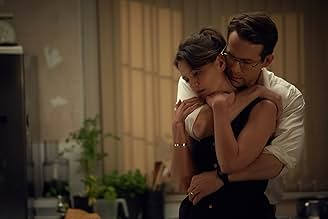VALUTAZIONE IMDb
7,3/10
64.331
LA TUA VALUTAZIONE
Maria Altmann, una rifugiata ebrea ottantenne, assume il governo austriaco per recuperare opere d'arte che ritiene appartengano di diritto alla sua famiglia.Maria Altmann, una rifugiata ebrea ottantenne, assume il governo austriaco per recuperare opere d'arte che ritiene appartengano di diritto alla sua famiglia.Maria Altmann, una rifugiata ebrea ottantenne, assume il governo austriaco per recuperare opere d'arte che ritiene appartengano di diritto alla sua famiglia.
- Premi
- 6 candidature
Trama
Lo sapevi?
- QuizOprah Winfrey was, for ten years, the owner of Gustav Klimt's second-most-famous portrait of the subject of the painting unofficially known as "Woman in Gold." The second most famous Klimt portrait of Bloch-Bauer was officially titled "Adele Bloch-Bauer ll." Winfrey reportedly bought the painting anonymously in 2006, when Christie's sold it at auction for $87.9 million, during the same auction session when the subject of this film was sold, along with four other Klimt paintings owned by Maria Altmann's family. In 2016, Winfrey sold the 54"x54" painting, "Adele Bloch-Bauer II," to a Chinese collector for $150 million.
- BlooperWhen Randy Schoenberg is before the Supreme Court, he is shown being asked a convoluted question by Chief Justice William Rehnquist, whereupon Schoenberg admits he doesn't understand it. That question was actually posed by Justice David Souter. The reaction from the other justices, who also didn't understand the question, was accurately depicted.
- Citazioni
Randol Schoenberg: It's hard to believe Hitler once applied to be an art student here.
Maria Altmann: I wish they'd have accepted him.
Recensione in evidenza
The lady in question is Adele Bloch-Bauer who was the subject of a magnificent painting, deploying lots of gold, by the Austrian artist Gustav Klimt. Following the Anschuss of 1938 when Germany took over Austria, this painting was one of many, many artefacts seized by the Nazis from Jewish families in occupied Europe.
The film tells the story - a little fictionalised - of Adele's niece Maria Altmann who escaped from Vienna to live in California and, during the 1980s as an octogenarian, pursued an audacious claim to take back this painting and other Klimt works from the Austrian Government. Helen Mirren is brilliant as Altmann in another distinguished performance in a sparkling career during which she has played everything from "The Queen" to an assassin (RED"), while Ryan Reynolds is surprisingly good as her lawyer Randy Schoenberg in a role a million miles from "Green Lantern" or "Deadpool".
There's a lot going on in this film: legal battles over the art work with some classic courtroom scenes, flashbacks (in sepia colours) to Altmann's earlier life in 1930s Vienna, and an evolving relationship between the irascible Altmann and the idealistic Schoenberg, both descendants of famous Austrians. This is not the kind of film that was ever going to be a major box office draw but it is certainly worth a home viewing.
The film tells the story - a little fictionalised - of Adele's niece Maria Altmann who escaped from Vienna to live in California and, during the 1980s as an octogenarian, pursued an audacious claim to take back this painting and other Klimt works from the Austrian Government. Helen Mirren is brilliant as Altmann in another distinguished performance in a sparkling career during which she has played everything from "The Queen" to an assassin (RED"), while Ryan Reynolds is surprisingly good as her lawyer Randy Schoenberg in a role a million miles from "Green Lantern" or "Deadpool".
There's a lot going on in this film: legal battles over the art work with some classic courtroom scenes, flashbacks (in sepia colours) to Altmann's earlier life in 1930s Vienna, and an evolving relationship between the irascible Altmann and the idealistic Schoenberg, both descendants of famous Austrians. This is not the kind of film that was ever going to be a major box office draw but it is certainly worth a home viewing.
- rogerdarlington
- 18 set 2016
- Permalink
I più visti
Accedi per valutare e creare un elenco di titoli salvati per ottenere consigli personalizzati
- How long is Woman in Gold?Powered by Alexa
Dettagli
- Data di uscita
- Paesi di origine
- Siti ufficiali
- Lingue
- Celebre anche come
- La dama de oro
- Luoghi delle riprese
- Aziende produttrici
- Vedi altri crediti dell’azienda su IMDbPro
Botteghino
- Budget
- 11.000.000 USD (previsto)
- Lordo Stati Uniti e Canada
- 33.307.793 USD
- Fine settimana di apertura Stati Uniti e Canada
- 2.091.551 USD
- 5 apr 2015
- Lordo in tutto il mondo
- 61.619.773 USD
- Tempo di esecuzione1 ora 49 minuti
- Colore
- Mix di suoni
- Proporzioni
- 2.35 : 1
Contribuisci a questa pagina
Suggerisci una modifica o aggiungi i contenuti mancanti

Divario superiore
By what name was Woman in Gold (2015) officially released in India in English?
Rispondi








































